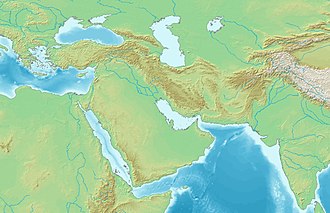Top Qs
Timeline
Chat
Perspective
Ziwiye hoard
Treasure hoard discovered in Ziwiyeh, Iran From Wikipedia, the free encyclopedia
Remove ads
The Ziwiye hoard is a treasure hoard containing gold, silver, and ivory objects, also including a few gold pieces with the shape of a human face, that was uncovered in a plot of land outside Ziwiyeh castle, near the city of Saqqez in Kurdistan province, Iran, in 1947.

Remove ads
Provenance
Objects from the hoard provide a link between the cultures of the Iranian plateau and the nomadic or Scythian art forms known as the "animal style". "The Scythian motifs adopted by Urartu account for the decoration of the great Treasure of Saqqez brought to light on the south shore of Lake Urmia," was Leonard Woolley's assessment (Woolley 1961 p 176).
Style
The hoard contains objects in four styles: "Median", Assyrian, Scythian, proto-Achaemenid, and the provincial native pieces. Dated ca. 700 BC, this collection of objects illustrates the situation of the Iranian plateau as a crossroads of cultural highways—not least of them the Silk Road—which fused disparate cultures to inform early Iranian art. The objects have also been related to finds at Teppe Hasanlu and Marlyk.[1]
Remove ads
Current location
Examples of the Ziwiye Treasure are scattered among public and private collections. A 'Ziwiye' provenance may have been applied to comparable objects that have passed through the trade since the 1960s. Items attributed to the hoard are currently in the collections of the Metropolitan Museum in New York, the Louvre in Paris and the British Museum in London.[2][3][4]
Controversy
The archaeologist Oscar White Muscarella has questioned the whole account of the finding of the hoard (as he has done with the older Oxus Treasure), pointing out that none of the items were excavated under archaeological conditions, but passed through the hands of dealers. He concludes that "there are no objective sources of information that any of the attributed objects actually were found at Ziwiye, although it is probable that some were", and that the objects have no historical and archaeological value as a group",[5] although many are genuine and "exquisite works of art".[6] In a later work Muscarella denounced several "Ziwiye" objects as modern forgeries.[7]
Remove ads
Gallery
- Gold necklaces
- Some pieces of Zewiye hoard
- Gold Rhyton in the form of a Ram's Head
- Golden plaque
- golden plaque
- Jug
- Ram-shaped pottery object
- Duck vase
- Bowl with base
- Marble bowl
- Tray
- Large earthenware jar
- Bracelet
- Soldier
- Golden piece
- Stone base
- Shield
- Necklaces
- Piece
See also
References
Sources
Wikiwand - on
Seamless Wikipedia browsing. On steroids.
Remove ads






















